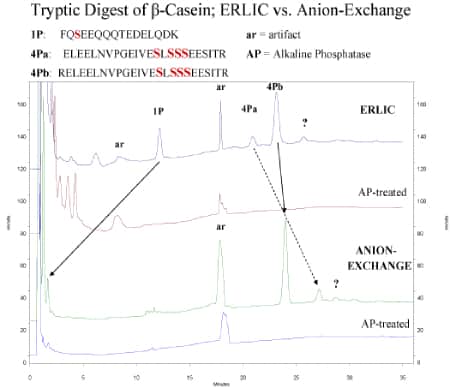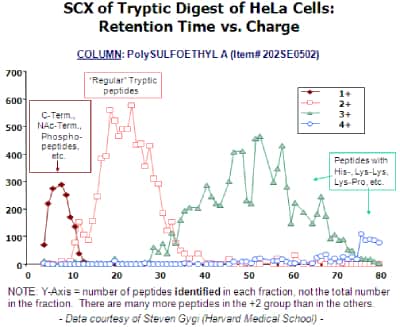Separation of Phosphopeptides

Get In Touch
ERLIC of peptides is normally performed with a PolyWAX LP™ column at a pH ~ 2.0, low enough to uncharge carboxyl- groups in peptides. Under these conditions, phosphate groups retain their negative charge and are electrostatically attracted to the column. This attraction is not sufficient to overcome the electrostatic repulsion from the two basic groups in a typical tryptic peptide (the N-terminus and the Lys- or Arg- residue at the C-terminus), which is why anion-exchange has not been used for selective isolation of phosphopeptides from tryptic digests. Phosphate groups are quite hydrophilic, though. In the ERLIC mode the combination of electrostatic attraction and hydrophilic interaction does suffice to pull phosphopeptides away from the nonphosphorylated peptides in a tryptic digest. This is clear from the following example, which contrasts retention of tryptic peptides from beta-casein on the same column in the ERLIC mode and in the anion-exchange mode.
Application Name : ERLIC of Phosphopeptides
Column Name : PolyWAX LP™ Columns
Analytes : Phosphopeptides

Isolation of Phosphopeptides and Other Classes of Peptides from Tryptic Digests: The typical tryptic peptide has a net charge of +2 at pH 2.7-3.0, due to the N-terminus and the Lys or Arg residue at the C-terminus. Attachment of a phosphate group lowers the net charge of the peptide to +1. Thus, the earliest-eluting SCX fractions are enriched in phosphopeptides, as well as C-terminal and blocked N-terminal fragments. The 200-Å pore version of PolySULFOETHYL A™ has a higher surface area than the 300-Å material normally used for proteomics and can pull the +2 peptides away from the +1 peptides reasonably completely [ABOVE]. Beausoleil et al. (PNAS 101 (2004) 12130) have used this approach to identity over 2000 phosphopeptides from the tryptic digest of HeLa cell lysate. In various studies, about 20-30% of the phosphopeptides in a really complex tryptic digest eluted in this +1 window. A good recent examination of this approach is: J.C. Trinidad et al., Mol. Cell. Proteomics 5 (2006) 914.
Application Name : HPLC Application Of SCX of Tryptic Digest of HeLa Cells
Column Name : PolySULFOETHYL A™ Columns
Analytes : Phosphopeptides
Get Your Quote or Call: 040-29881474
We focus on supporting laboratory workflows & optimizing lab-wide operations
